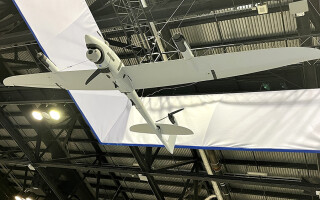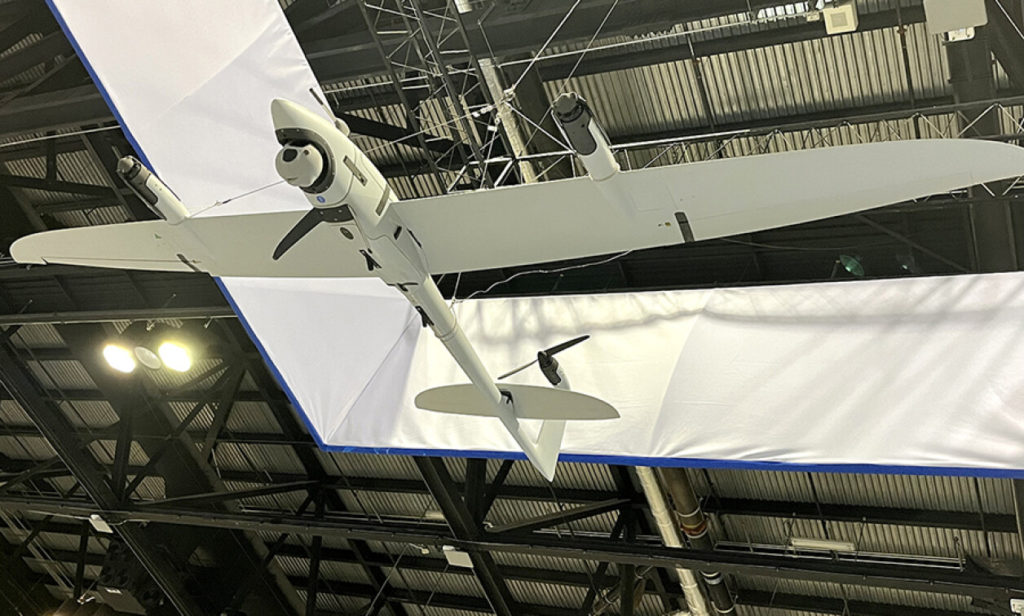Story
June 22, 2022

The Vector uncrewed aircraft system (UAS) – a fixed-wing electric vertical takeoff and landing (eVTOL) drone – made an effective battlefield debut in Ukraine for NATO allies, proving that such commercially developed systems can be deployed quickly for decisive wartime advantages.
Ukrainian and partner forces now also use the Vector for tactical mapping, mission planning, battle-damage assessment, and collecting evidence of war crimes. The first one was delivered in Ukraine in early May of 2022. According to QS Inc. CEO Dave Sharpin, himself a US Air Force veteran, more Vectors are on the way to assist Ukraine.
Developed by Quantum-Systems Inc. (QS Inc., Moorpark, California), the US subsidiary of Munich, Germany-based Quantum-Systems GmBH, the Vector has disrupted existing defense and security markets with its fully autonomous, artificial intelligence (AI)-infused two-in-one design.
The Vector is lightweight and backpack-transportable, easily able to convert from a fixed-wing craft to a quad that can fly either autonomously or tethered (“The Scorpion”). In its fixed-wing mode, the 7.4 kg (16.3 pound) Vector can fly for about 120 minutes at cruise speeds of 15-20 m/sec. (49 to 66 feet/sec.). It can take off in a variety of challenging environments, including at altitudes as high as 3,000 m (9,843 feet) above mean sea level (AMSL). In its multicopter configuration, the 5 kg (11 pound) Vector can fly as long as 45 minutes at cruising speeds of 0 to 15 m/sec. (0 to 49 feet/sec.). When tethered, it comes with a 70 to 100 m (230 to 328 foot) cable, which can quickly disconnect from the aircraft to enable it to fly away. (See figure.)
In any configuration, a single operator can assemble and deploy this modular kit-based system within three minutes. The ground control station (GCS) consists of a high-performance x86-based personal computer with touch screen functionality and controls, protected in a rugged case.
Operationally, the UAS includes an integrated test system of actuators that are fully controlled by a controller area network (CAN). Its rich communication services (RCS) enable operators to adjust mission plans literally on the fly, while remaining cybersecure through a mesh IP-encrypted datalink. It also has an automatic return-to-base feature for emergency scenarios.
It also features United Nations-certified heated lithium-ion batteries that maintain cells at 15 °C (59 °F), rain- and dust-protected airspeed sensors, a cooling system to protect data links and electronics, shock-absorbing landing gear and a quick-lock mechanism, all encapsulated in a fiber-reinforced plastic airframe. A key feature for combat operations: The company built the system to be quiet and difficult to detect, remaining inaudible at 200 m (656 feet) altitude and slant range. Camouflage matte paint adds to its low observability profile.
The vehicle avionics package comes with detachable gimbals that plug-and-play with an agnostic range of sensors to enhance data collection. Recently, QS Inc. added Australia-based Ascent Vision Technologies’ Micro Gimbal, the CM62, to its design. The CM62 is a small gyro-stabilized multisensory gimbal used for imaging and a range of surveillance duties, all contained in a sub-260 g (0.57 pound) system. This addition provides for improved beyond-line-of-sight situational awareness.
It also leverages advanced artificial intelligence (AI) capabilities, supported by automatic identification and tracking algorithms for dynamic data collection and assessment. On the back end, its mesh IP network provides GPS coordinates to capture targets. This setup integrates with AI/edge computing capabilities that bolster advanced tracking, detection, and classification interfaces; enhance command-and-control battle-management systems; and enable operations in GNSS-denied areas.
A variety of use cases
The QS team designed Vector primarily for all-environment tactical intelligence, surveillance, and reconnaissance (ISR) and reconnaissance, surveillance, and target acquisition (RTSA). By combining the advantages of both helicopters and airplanes, Vector provides both close-in support and long-range coverage of large areas and long corridors. Once deployed, it can provide actionable intelligence out to 25 km (15-plus miles), even in remote areas.
Quantum now plans to build “drone ports,” with a vision of a base to which aircraft return to recharge, with another deploying autonomously to take its place.
“Because the UASs operate autonomously, the operator will only need to focus on targets. This will decrease operator workloads,” Sharpin explains. “More importantly, by removing operators from hot zones, our drone port will ultimately save lives.”
Dawn MK Zoldi (Colonel, USAF, Retired) is the CEO of P3 Tech Consulting LLC.


